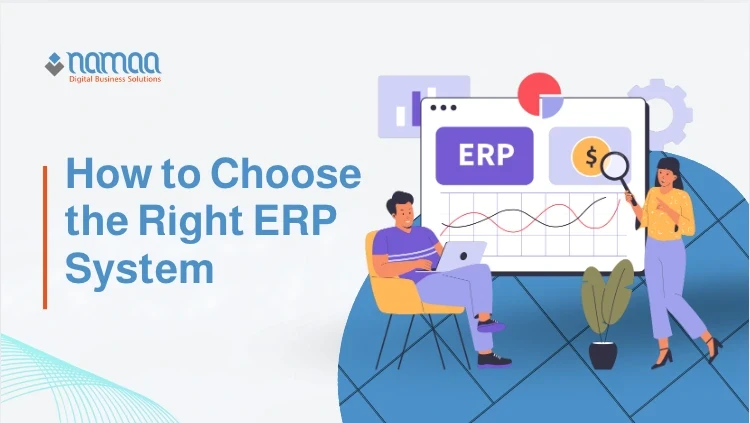How to Choose the Right ERP System for Your Business
Enterprise Resource Planning (ERP) systems are essential for business success, helping organizations optimize operations, coordinate resources, and enhance efficiency. With a wide range of ERP solutions available, selecting the right system can be a challenging decision requiring careful evaluation. The chosen system must align with current business needs, support future growth, and balance cost with functionality. This guide explores key factors to consider when choosing an ERP system and outlines the steps to ensure maximum ROI from this investment.
Why Choosing the Right ERP System Is Crucial for Business Success
In today’s competitive market, selecting the right ERP system is a critical factor in business success. Companies need flexible and powerful tools to enhance operational efficiency, improve strategic decision-making, and drive sustainable growth. A well-integrated ERP solution provides a comprehensive view of business operations, covering inventory management, HR, sales, marketing, and finance.
By consolidating these functions into a unified system, businesses can:
✔ Streamline workflows and improve data accuracy
✔ Reduce operational costs through automation
✔ Enhance communication between departments
Additionally, ERP automation eliminates repetitive tasks, allowing employees to focus on high-value activities. The system also delivers real-time reporting and analytics, empowering management with data-driven insights for better decision-making.
A properly implemented ERP system also strengthens customer and supplier relationships by providing accurate product, service, and scheduling information. Ultimately, choosing the right ERP system helps businesses gain a competitive edge by enhancing operational agility, innovation, and long-term growth.
However, businesses must carefully assess their requirements and evaluate available ERP solutions before making a final decision.
How to Choose the Right ERP System
As digital transformation accelerates, selecting the right ERP solution is key to maximizing productivity and scalability. Here are the essential factors to consider and practical steps to guide your decision:
1. Identify Business Needs & Objectives
Before researching ERP systems, businesses should clearly define their operational challenges and goals:
✔ Are you struggling with supply chain inefficiencies?
✔ Do you need better data integration across departments?
✔ What financial and operational improvements are you looking to achieve?
? Steps:
✔ Outline key business objectives for ERP implementation.
✔ Identify current inefficiencies in operations.
✔ Consult employees across departments to understand their needs.
2. Set a Realistic Budget
ERP costs vary based on factors such as system complexity, data volume, and user count. Consider the following when setting a budget:
✔ Software purchase or subscription fees (for cloud ERP solutions)
✔ Implementation costs, including system integration
✔ Ongoing maintenance and upgrade expenses
✔ Training and customer support costs
3. Choose the Right ERP Deployment Model
There are two main types of ERP solutions:
✔ On-Premises ERP: Installed within company servers, offering greater data control but requiring high infrastructure investment.
✔ Cloud ERP: Hosted online, reducing maintenance costs while providing greater accessibility and scalability.
? Key Considerations:
✔ On-Premise ERP is ideal for large enterprises needing full data control.
✔ Cloud ERP suits businesses needing flexibility, remote access, and cost-efficiency.
4. Ensure Scalability for Business Growth
As businesses expand, their ERP system must accommodate growth:
✔ Can the ERP handle more users over time?
✔ Does it allow for future feature expansions?
✔ Does the provider offer frequent updates for evolving needs?
5. Compare ERP Features & Functionality
Different ERP systems offer varied functionalities. Compare options based on:
✔ Core features like inventory management, accounting, and HR integration.
✔ Industry-specific functionalities (e.g., manufacturing ERP vs. retail ERP).
✔ User-friendly interface for faster employee adoption.
6. Ensure Compatibility with Existing Software
The ERP system should seamlessly integrate with other business tools like:
✔ Customer Relationship Management (CRM) systems
✔ E-commerce platforms
✔ Accounting software
? Tips:
✔ Check for API compatibility to enable smooth data transfer.
✔ Run a compatibility test before full implementation.
7. Prioritize Data Security & Compliance
With increasing cybersecurity threats, ERP security is non-negotiable:
✔ Check encryption standards for data protection.
✔ Ensure disaster recovery plans for system failures.
✔ Confirm compliance with ISO 27001, GDPR, or local regulations.
8. Evaluate User Experience & Ease of Adoption
A complex ERP system can slow down operations. Choose a solution that:
✔ Has an intuitive user interface
✔ Requires minimal training for employees
✔ Offers a free trial for usability testing
9. Assess Vendor Support & Post-Implementation Services
Reliable customer support ensures seamless ERP adoption.
✔ Does the vendor provide 24/7 technical support?
✔ Are detailed user guides & training materials available?
✔ What are the long-term upgrade and maintenance policies?
10. Request Demos & Compare ERP Vendors
Before committing, businesses should:
✔ Request customized ERP demos from multiple vendors.
✔ Compare pricing, features, and implementation timelines.
✔ Seek feedback from other businesses using the same ERP.


.webp)




